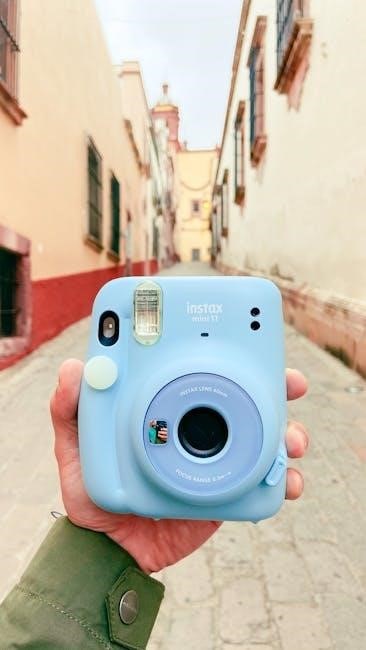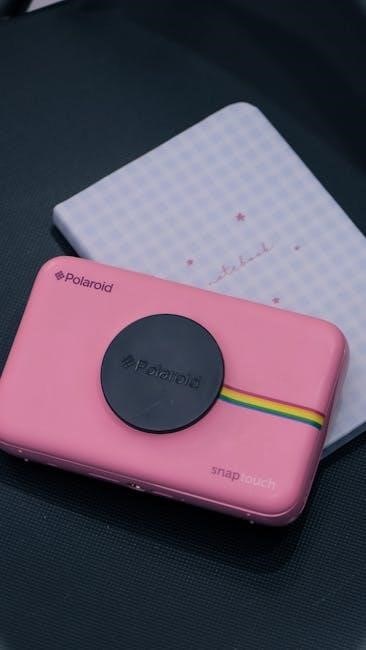Here is the information for the ” section:

The Polaroid Snap is an instant print digital camera designed for simplicity and fun. This guide provides comprehensive instructions to help you master its features. From turning the camera on to printing photos and troubleshooting, this manual ensures you capture and share memories instantly. Enjoy the experience!
Here is the information for the ” section:
Unboxing and Initial Setup
Congratulations on purchasing your Polaroid Snap! Let’s get started with the unboxing and initial setup. First, carefully open the box and ensure you have all the components: the Polaroid Snap camera, a USB cable, a wrist strap, and a Quick Start Guide.
Remove all protective packaging from the camera. Inspect the device for any signs of damage. If everything looks good, attach the wrist strap to the designated anchor point on the camera to prevent accidental drops. Now, let’s prepare the camera for its first use.
Before powering on, ensure you have Polaroid Premium ZINK paper. Open the paper compartment by sliding the latch and insert a new pack of ZINK paper, ensuring the blue calibration sheet is at the bottom. Close the compartment securely. Next, charge the camera using the provided USB cable by connecting it to a power source. Allow it to charge fully before proceeding, indicated by the battery status LED. You’re now set for instant photography fun!
Here is the information for the ” section:
Powering On and Off
Understanding how to properly power your Polaroid Snap on and off is crucial for conserving battery life and ensuring smooth operation. The Polaroid Snap utilizes a unique power mechanism integrated with its pop-up viewfinder. To power on your camera, gently press on the viewfinder. This action will cause the viewfinder to pop up, simultaneously activating the camera.

You’ll know the camera is on when the internal systems initialize, and the status LEDs illuminate briefly. Conversely, to turn the camera off, apply slight pressure to the viewfinder to return it to its closed position. This action will shut down the camera, conserving battery power when not in use.
It’s important to ensure the viewfinder is fully closed to completely power off the device. The Polaroid Snap also features an auto-sleep mode to further conserve battery. If left inactive for several minutes, it will automatically go into sleep mode. To wake it up, simply close and re-open the viewfinder. Mastering this simple process will extend your camera’s usability.
Here is the information for the ” section:
Taking Photos: Basic Operation
Taking photos with your Polaroid Snap is designed to be intuitive and straightforward. Once the camera is powered on by opening the viewfinder, you’re ready to start capturing memories. Ensure that the lens cap is removed to avoid any obstructions. To take a photo, simply point the camera at your subject and press the shutter button located on the top of the camera.
The camera will automatically focus and flash, ensuring a well-lit and clear image. There are no manual focus adjustments required, making it perfect for quick snapshots. After pressing the shutter button, the camera will capture the image and, if paper is loaded, will automatically begin printing it.
The Polaroid Snap is built to capture and print one 10MP image at a time. To take another photo, simply repeat the process. Remember to keep the lens clean and avoid covering the flash for optimal results. Experiment with different angles and subjects to fully explore the creative possibilities of your Polaroid Snap.
Here is the information for the ” section:
Printing Photos
Printing photos with the Polaroid Snap is seamless and instant. Once you’ve taken a photo, the camera will automatically begin the printing process, provided that ZINK paper is correctly loaded in the paper compartment. The Polaroid Snap uses ZINK Zero Ink technology, which means no ink cartridges are needed; the color is embedded within the paper itself.
The printing process typically takes a few moments. During this time, avoid opening the paper door, as this can cause printing errors or paper jams. The printed photo will emerge from the slot on the side of the camera. Be patient and allow the photo to fully eject before touching it.
If the paper status LED indicator blinks red, it indicates a paper-related error. This could mean a paper jam, incorrect paper type, or an empty paper tray. To resolve this, open the paper compartment, correct the issue, and restart the camera. Use only Polaroid Premium ZINK Paper to ensure optimal print quality. Enjoy your instant prints!
Here is the information for the ” section:
Inserting and Refilling ZINK Paper
To ensure your Polaroid Snap can instantly print your cherished memories, understanding how to insert and refill the ZINK paper is crucial. The Polaroid Snap uses 2×3 Premium ZINK Zero Ink Paper. To begin, locate the paper door latch on the side of the camera. Gently slide the latch to open the paper compartment.
When inserting the ZINK paper, ensure you place the entire stack with the blue Smartsheet facing down. The Smartsheet is essential for calibrating the printer and ensuring optimal print quality. Do not load more than one 10-pack of Premium ZINK Paper at a time, as overfilling can damage the printer mechanism. Gently close the paper door until it clicks shut.
If you encounter any issues, such as paper jams or the paper status LED blinking red, double-check that the paper is correctly loaded and that you are using the recommended Polaroid Premium ZINK Paper. Restart your camera after correcting any errors. This simple process ensures your Polaroid Snap is always ready to print.
Here is the information for the ” section:
Understanding Paper Dos and Don’ts
To maintain the print quality and longevity of your Polaroid Snap photos, it’s essential to understand the dos and don’ts regarding ZINK paper. Always use Polaroid Premium ZINK Paper to ensure vivid, clear, and dry-to-the-touch prints ready for sticking. When handling the paper, do hold it by its edges to avoid transferring oils or dirt to the surface, which can affect print quality.
Avoid bending the ZINK paper, as creases can cause printing errors or jams. Never insert more than ten sheets at a time to prevent damaging the printer mechanism. Do not expose the paper to extreme temperatures or humidity before use. Also, do not touch the glossy surface of the paper to maintain optimal print quality.
If a paper jam occurs, do carefully remove the jammed paper, ensuring no small pieces remain inside the camera. Avoid using any other type of paper, as the Polaroid Snap is specifically designed for ZINK paper. Following these simple guidelines will keep your Polaroid Snap functioning smoothly.
Here is the information for the ” section:
Inserting and Removing SD Card
The Polaroid Snap features an SD card slot, allowing you to save digital copies of your photos in addition to printing them. To insert an SD card, first locate the SD card slot on the side of your camera. Gently guide the SD card into the slot, ensuring it’s oriented correctly with the gold contacts facing the appropriate direction, typically towards the back of the camera.
You’ll feel a slight click when the SD card is securely inserted. To remove the SD card, gently press it inward until you hear a click sound. This will release the card, allowing you to pull it out. Always ensure the camera is powered off before inserting or removing the SD card to prevent data corruption or damage to the card.

Handle the SD card with care, avoiding bending or scratching it. Also, avoid inserting or removing the SD card in humid or dusty environments. Following these steps ensures smooth operation and prolongs the life of both your SD card and your Polaroid Snap.
Here is the information for the ” section:

Understanding SD Card Memory
The Polaroid Snap uses SD cards to store digital copies of your photos, supplementing its internal memory which is limited to capturing and printing one 5MP image at a time. The amount of photos and videos an SD card can hold depends on its capacity, measured in gigabytes (GB). Higher capacity SD cards can store significantly more data.
When choosing an SD card, consider the balance between capacity and speed. A faster SD card allows for quicker saving of images and videos, reducing wait times. Refer to the Polaroid Snap’s specifications for the maximum supported SD card capacity. Overfilling the SD card can lead to errors or prevent the camera from saving new images.
Regularly transfer photos and videos from your SD card to a computer or external storage to free up space and maintain optimal performance. Also, consider formatting the SD card periodically using the camera’s formatting option to ensure data integrity and compatibility. This will help prevent potential data corruption and ensure smooth operation of your Polaroid Snap.
Here is the information for the ” section:
Using the Self-Timer
The Polaroid Snap features a self-timer function, allowing you to include yourself in group photos or capture creative shots with a delayed shutter release. To activate the self-timer, locate the timer button on the top of the camera; Pressing this button engages the ten-second self-timer.
Once the timer button is pressed, it will begin to blink white, indicating that the timer is counting down. Position yourself or your subject within the frame before the timer elapses. After ten seconds, the camera will automatically capture the photo. Ensure the camera is stable during the countdown to avoid blurry images.
The self-timer is particularly useful for group portraits or situations where you need time to set up the perfect shot. Remember to consider the background and lighting while positioning yourself. Experiment with different angles and poses to make the most of the self-timer function. The blinking white light serves as a visual cue, allowing you to prepare for the photo capture.
Here is the information for the ” section:
Adding Photo Effects and Borders
Enhance your Polaroid Snap photos with built-in effects and borders to add a touch of creativity and personalization. The camera offers several color modes, including normal, black and white, and vintage sepia, allowing you to achieve different aesthetic styles. To switch between these modes, locate the color mode selector button on the camera.

Pressing this button cycles through the available color options, each altering the look and feel of your photos. Additionally, you can add a classic Polaroid border to your prints. This border provides a nostalgic frame around your image, reminiscent of traditional Polaroid photos. To enable or disable the Polaroid border, use the dedicated border selector button.

Experiment with combining different color modes and the Polaroid border to create unique and eye-catching prints. The black and white mode offers a timeless, artistic feel, while the sepia mode adds a warm, vintage tone. The Polaroid border completes the look, making each print a distinctive keepsake. These simple yet effective features allow you to customize your photos directly from the camera.

Here is the information for the ” section:
Troubleshooting: Paper Jams and Errors
Encountering a paper jam or error with your Polaroid Snap can be frustrating, but resolving these issues is usually straightforward. A common indicator of a problem is when all the status LEDs blink red. This typically signifies a paper jam, incorrect paper type, or another paper-related error.
If you suspect a paper jam, begin by carefully opening the camera’s paper door. Gently inspect the paper path for any obstructions or misaligned sheets. If you find a jam, delicately remove the stuck paper, ensuring not to tear it, as small pieces can cause further issues. Ensure you are using only Polaroid Premium ZINK Paper, as other types can cause errors. Also, avoid overfilling the paper compartment; exceeding ten sheets can damage the printer mechanism.

Once you have cleared any obstructions and verified the paper is correctly loaded, close the paper door securely. Restart the camera by closing and reopening the viewfinder. If the error persists, consult the user manual for specific error codes and further troubleshooting steps. Regular maintenance and careful handling of the ZINK paper will minimize the likelihood of future jams.
Here is the information for the ” section:
Battery and Charging Information
Understanding the battery and charging aspects of your Polaroid Snap is crucial for optimal performance. The camera is designed to conserve power, featuring an auto-sleep mode that activates after a period of inactivity. To wake the camera, simply close and reopen the viewfinder.
When the battery is low, the battery status LED will indicate the need for charging. To charge your Polaroid Snap, use the provided micro USB cable. Connect the cable to the micro USB connector on the camera and plug the other end into a USB power source, such as a computer or a wall adapter. During charging, the battery status LED will illuminate, indicating the charging progress. Once fully charged, the LED will typically change color or turn off.

Avoid using the camera in extreme temperatures, as this can affect battery performance and lifespan. Also, ensure the charging port is free from debris to maintain a stable connection. If you experience issues with charging, verify the USB cable and power source are functioning correctly. Regular charging and proper care will help extend the battery life of your Polaroid Snap.